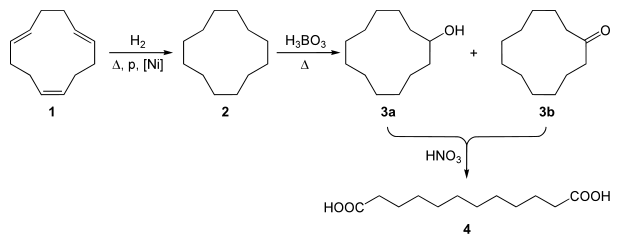Dodecanedioic acid
 | |
| Names | |
|---|---|
| IUPAC name
Dodecanedioic acid | |
| Other names
DDDA | |
| Identifiers | |
3D model (JSmol) |
|
| ChEBI | |
| ChemSpider | |
| ECHA InfoCard | 100.010.680 |
| KEGG | |
PubChem CID |
|
| |
| |
| Properties | |
| C12H22O4 | |
| Molar mass | 230.30 g·mol−1 |
| Appearance | White flakes |
| Density | 1.066 g/cm3 |
| Melting point | 127–129 °C (261–264 °F; 400–402 K) |
| Boiling point | 245 °C (473 °F; 518 K) |
| pH dependent | |
| Hazards | |
| Flash point | 220 °C (428 °F; 493 K) |
Except where otherwise noted, data are given for materials in their standard state (at 25 °C [77 °F], 100 kPa). | |
| Infobox references | |
Dodecanedioic acid (DDDA) is a dicarboxylic acid mainly used in antiseptics, top-grade coatings, painting materials, corrosion inhibitors, surfactants, and engineering plastics such as nylon 612.[1]
Experimental work with dodecanedioic acid in type 2 diabetic patients has demonstrated that IV infusion helps to maintain normal blood sugar and energy levels without increasing the blood glucose load in the process.[2]
Production
Synthetic production
DDDA is typically produced through two methods. It has traditionally been produced from butadiene using a multi-step chemical process.[3] Butadiene is first converted to cyclododecatriene through a cyclotrimerization process.[4]
Cyclododecatriene (1) is converted to dodecanedioic acid (4) by hydrogenation to cyclododecane (2) followed by air oxidation in the presence of boric acid at elevated temperatures to a mixture of the alcohol (3a) and the ketone (3b). In the final step, this mixture oxidized further by nitric acid.

Biotech production
A biotechnology is used to convert paraffin wax into DDDA with a special strain of Candida tropicalis yeast in a multi-step process.[5] Verdezyne has created a method to use plant-oil sourced feedstocks, which makes it the only producer using renewable feedstocks for DDDA.[3]
References
- ↑ "Nylon-6,12".
- ↑ Greco, A. V.; Mingrone, G; Capristo, E; Benedetti, G; De Gaetano, A; Gasbarrini, G (1998). "The metabolic effect of dodecanedioic acid infusion in non-insulin-dependent diabetic patients". Nutrition. 14 (4): 351–7. doi:10.1016/s0899-9007(97)00502-9. PMID 9591306.
- 1 2 "BIOLON® DDDA". verdezyne.com. Retrieved 2016-09-23.
- ↑ Klaus Weissermel, Hans-Jurgen Arpe (1997). Industrial Organic Chemistry (3rd ed.). John Wiley & Sons. ISBN 3-527-28838-4.
- ↑ "Products". www.hilead-europe.com. Retrieved 2016-09-23.